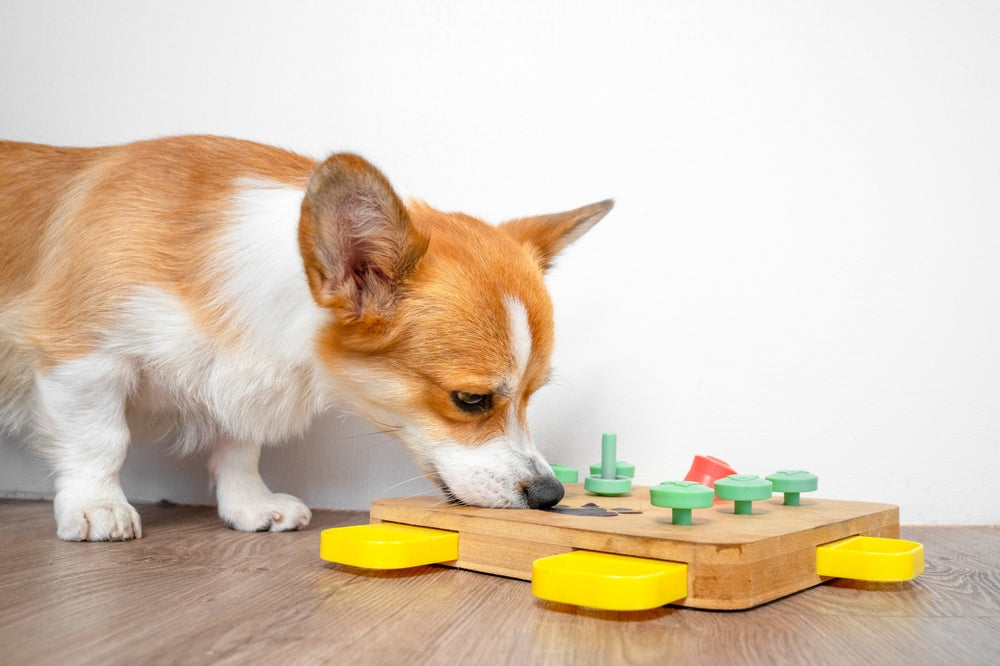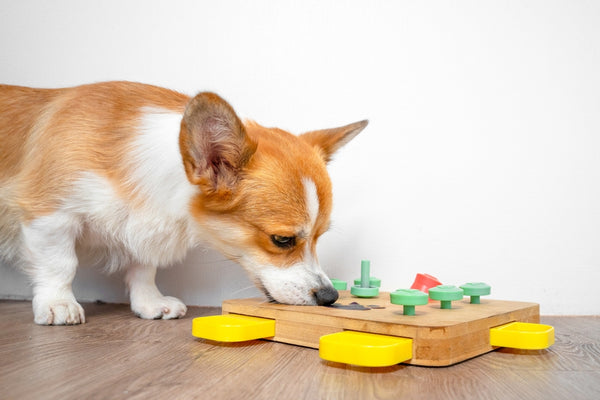The Importance of Mental Stimulation for Dogs: Keeping Their Minds Sharp and Active
Posted by Jackie Ly on Apr 24, 2024

Table of Contents
Why Dogs Need Mental Stimulation
What happens if dogs don’t get the mental stimulation they need?
Fun and Simple Mental Stimulation Activities for Dogs
As a dog owner, you want your dog to stay healthy and live a long life. That’s why you properly and consistently train them, feed them good food, give them their basic needs, and exercise them regularly.
But, there’s one thing you’re forgetting: their mental health is equally important! If you see them lying all day or sleeping most of the time and you think that’s all they need, nu-uh! Dogs can only engage in so many activities on their own. They’re waiting for you to do engaging activities with them, or give them mentally stimulating toys they can play with or solve.
Here are the benefits of mental stimulation to your dogs, and what activities you can do to keep them mentally healthy.
Why Dogs Need Mental Stimulation
For enrichment
Dogs, like humans, thrive on mental stimulation. Engaging their minds with various activities not only provides entertainment but also enhances their overall well-being. Mental stimulation can come in many forms, such as puzzle toys, interactive games, and training exercises.
These activities challenge their cognitive abilities, keeping their brains active and alert. Just as a lack of mental stimulation can lead to boredom and frustration, providing enrichment helps fulfil their natural instincts and keeps them content and fulfilled.
To lessen hyperactivity
Your dog can only engage in so many activities on their own. If your dog is at home for the majority of the day with nothing to keep them occupied, they will most likely be bursting with activity. Hyperactivity might be a nuisance at first, but it can quickly escalate into a more serious problem!
If your dog seems constantly on the go, lacking mental stimulation could be a contributing factor. Without enough mental challenges, they may resort to hyperactive behaviours like excessive barking or restlessness. Engaging their mind through training exercises or interactive play helps channel their energy in a positive direction, leading to a calmer and more balanced demeanour.
To minimise aggressive behaviours
Proper mental stimulation will reduce your dog's tendency to become aggressive. Bored dogs are irritable dogs, and cranky dogs are more prone to be aggressive towards humans and other animals, according to research.
Proper mental stimulation engages your dog's mind, providing an outlet for their energy and reducing frustration. This mental engagement builds a sense of contentment and fulfilment, minimising the likelihood of aggressive outbursts, and promoting a more harmonious relationship between your dog and those around them!
To get rid of destructive behaviour
If your dog is exhibiting destructive behaviour, such as chewing on furniture or digging holes, it might be due to boredom and excess energy. Engaging them in mentally stimulating activities will help them channel their energy and natural instincts.
Engaging in activities like puzzle toys, interactive games, and training sessions redirects their attention, helping to discourage destructive habits and encourage more constructive behaviours.
To instil positive behaviours in puppies
Playtime, socialisation, and intellectually stimulating games and toys are essential for young dogs' early growth. A new study shows that it boosts puppies' confidence, teaches them right behaviour, and provides an outlet for their excess energy. They will learn healthy habits and how to avoid destructive behaviours, preparing them for a life with minimal cognitive issues.
To keep senior dogs mentally healthy
Senior dogs, in particular, need plenty of mental stimulation as their brain activity decreases. While the most significant aspect in determining a senior dog's mental health will be how much stimulation they have received throughout his life, it is equally crucial not to ignore it in their later years.
It may be more challenging with senior dogs, but puzzle toys containing treats and socialisation are the two most effective ways to stimulate them.
To keep your dog sharp
Your dog's brain, like their muscles, needs regular stimulation to prevent premature ageing.
It's proven that dogs who are not mentally stimulated throughout their lives are more likely to have cognitive dysfunctions as they age. A basic interactive toy with rewards that allows your dog to solve the puzzle will be very helpful.
For senior dogs, mental stimulation not only keeps them sharp by combating symptoms of dementia, anxiety, and depression, but it also provides a strong foundation for raising smart and happy puppies.
To strengthen your relationship
When you engage in mental stimulation activities with your dog, you're not just keeping them entertained; you're also deepening your bond!
Whether it's training sessions, interactive play, or exploring new adventures together, these shared experiences create moments of connection and understanding. As you work together, you build trust and mutual respect, strengthening the relationship between you and your dog.
To keep them happy!
Providing your dog with regular mental stimulation is more than just keeping them engaged; it is also about making them happy!
Dogs thrive on mentally stimulating and enlightening situations that allow them to express their natural instincts. Whether it's a stimulating puzzle toy, a game of hide-and-seek, or learning a new trick, these activities bring happiness and fulfilment into their lives, keeping their tails wagging and their spirits high.
What happens if dogs don’t get the mental stimulation they need?
Dogs who do not receive enough mental stimulation may develop undesirable behaviours. Many dogs will discover ways to get the mental stimulation they need, but these self-selected “fun activities” are often ones that we humans do not appreciate. A chewed-up couch, pulled-down curtains, or excessive digging in your home plants are all indications that your dog is bored.
If your dog isn't mentally stimulated enough, they might start doing the same things over and over again, like some animals in zoos do. For example, they might run around the house for no reason. If you see this happening, it's time to do something about it.
Also, if your dog is older, you might think they just want to sleep all day and don't need to play. But it's important to know that older dogs' brains can get weaker if they don't get mental exercise. So, it's essential to include activities that challenge their minds to keep their brains active and healthy for longer.
Fun and Simple Mental Stimulation Activities for Dogs
Agility training
This is not just for ribbons, but for your dog’s health and yours, too. It’s a fun activity for you and your dog. Can your dog climb ramps, jump over obstacles, and wriggle through tunnels? These also have real-life applications they can use for hiking or perhaps survival if something unthinkable happens.
Even if you don't have fancy equipment, you can set up a simple agility course in your backyard using everyday items like hula hoops, cones, or even cardboard boxes. Teach your dog to weave between obstacles, jump over low hurdles (you can use broomsticks or small logs), and navigate tunnels made from blankets or PVC pipes.
Use commands like “Stay”, “Jump”, “Come”, and “Go” to direct them. Engaging your dog in agility courses also stimulates their mind as they learn to follow commands and problem-solve through the obstacles.
Obedience training
Obedience training isn't just about basic commands like sit and stay; it can also include fun and fancy tricks that challenge your dog's mind. You can level up or keep adding to your dog’s repertoire throughout their life.
Teach them to roll over, shake hands, play dead, or even fetch specific items by name! By incorporating a variety of tricks into your obedience training sessions, you keep your dog mentally engaged and eager to learn. This not only strengthens your bond but also provides enrichment that extends beyond mere obedience, fulfilling their natural curiosity and intelligence.
Add variety to your walks
Dogs are naturally curious and like exploring. Instead of walking the same block every day, mix it up a little. Take a new route, visit other parks, or hike new trails to allow your dog to discover new sights, sounds, and smells. While physical activity is important, give them plenty of time to sniff and investigate. This is how they explore the world.
Play “peekaboo”
Introduce your dog to the “peekaboo” game! Hide behind a corner or door while calling out excitedly. When they find you, praise them enthusiastically. Increase the challenge gradually by hiding in different rooms or behind objects when they’re not looking. Give them a reward when they successfully find you!
This game encourages your dog to use their senses to find you, boosting their confidence and independence! It's a fun activity that the whole family can enjoy together, indoors or outdoors, in safe areas.
Give them food dispensing toys and puzzle games
The pet industry has recognised the need for mental stimulation, and now there are a variety of food dispensing toys that can teach your dog to use their problem-solving abilities and work for their food. Treat balls, Kongs, and slow feeders are popular toys for dispensing treats or food. There are even complex puzzle toys ranging from beginner to expert levels.
Alternatively, you can make enrichment toys out of everyday household items, such as empty cardboard boxes filled with treats and taped shut, making it challenging for your dog to tear open and retrieve the rewards.
Do a treat search
When your dog is looking at you, say “find it” and throw a treat on the floor. Do this a few times until they catch on to the game. Then, make it a bit trickier. Let your dog watch as you hide the treat, like behind your foot or a nearby object. Say “find it” and give them time to figure it out.
Remember to look towards the hiding spot instead of looking at your dog, as they follow your gaze. Repeat this until they get it.
To make it more challenging, start hiding treats in different spots before saying "find it." Now, they really have to use their nose! The aim is to hide lots of treats around your home or yard for them to find. It's a great game for when you're busy or need to leave them alone, just remember not to leave them outside alone!
Leave the TV on with DVDs and livestreaming videos
There are DVDs and live streaming films on YouTube that you can set up for your dog to watch. These videos use real settings in nature, bird sounds, and music to keep a dog's mind engaged throughout the day. Leaving these DVDs or videos on during the day may provide excellent entertainment and stimulation for dogs.
Closing Thoughts
Prioritising mental stimulation is not just a luxury for your dog, it's a fundamental aspect of their overall well-being. By engaging their minds with stimulating activities, puzzles, and training exercises, you not only keep them physically fit but also nurture their cognitive abilities and emotional health.
A mentally stimulated dog is a happy, contented, and well-behaved companion, enriching our lives as much as we enrich theirs.
